A few years ago, I met a leader who wore her exhaustion like a badge.
She was always the first in the office, the last to leave, and the one who never said no. People admired her stamina. Her boss praised her dedication.
But behind the scenes?
She was crumbling.
Her team mirrored her pace—high-output, high-anxiety, and on the edge of burnout.
One day, in a workshop, she asked me this:
“If I slow down, will they stop respecting me?”
And I told her what I’ll tell you now:
Real resilience isn’t about pushing through everything. It’s about knowing what to push, what to protect, and when to pause.
We’ve been taught a broken version of resilience.
It sounds like:
- “Just power through.”
- “Work harder.”
- “Don’t show weakness.”
- “If you’re not tired, you’re not doing enough.”
But that’s not resilience.
That’s depletion.
True resilience isn’t measured by how long you can grind—it’s measured by how well you recover, reset, and lead through pressure without losing your people or yourself.
And that changes the way we define strength.
So what does resilience actually look like in leadership?
It’s not about being unshakeable.
It’s about being self-aware, adaptable, and grounded—even when everything else is uncertain.
Resilient leaders:
- Respond with calm instead of reacting with panic
- Model boundaries that make space for rest and clarity
- Ask for help, delegate well, and prioritize recovery
- Help their teams bounce back from setbacks with learning, not just labor
- Know how to reset culture when the pressure starts becoming toxic
Which brings us to a story you’ll want to hear.
The Bamboo Story—and the Shift It Taught Me
You’ve probably heard the metaphor of the Chinese bamboo.
For the first four years after it’s planted, there’s no visible growth. Nothing.
But underground, it’s building a strong, deep root system.
Then, in its fifth year, it can grow up to 80 feet in just six weeks.
That story stuck with me—not just because it’s powerful, but because it’s true of leadership too.
We spend so much time rushing to grow, perform, impress.
But the best leaders I’ve seen? They invest in their roots.
And when hard times come—because they will—those roots hold.
Resilience Is a System, Not a Personality Trait
The American Psychological Association defines resilience as the process of adapting well in the face of adversity, trauma, or stress. Not a superpower. Not perfection.
In Option B, Sheryl Sandberg and Adam Grant explain how resilience can be cultivated through meaning-making, emotional processing, and social support.
Grant writes:
“Resilience is not a fixed trait. It’s a muscle we can strengthen—with the right habits, environment, and leadership.”
In short: it’s not about how tough you are.
It’s about how well you train—and how well you lead others through the same.
How to Build Resilience—Without Burning Yourself or Others
Here’s what it can look like in real leadership practice:
- Start with honesty. Normalize talking about setbacks, stress, and overwhelm.
- Lead with rhythm, not rush. Establish healthy work cycles with recovery built in.
- Make meaning visible. Remind your team why they’re doing what they’re doing.
- Coach recovery, not just performance. Teach your team to pause, reflect, and learn after pressure moments.
- Check your pace. If you never slow down, your team won’t either. That’s not strength—it’s strain.
And most of all—make space for reflection.
Because people don’t burn out from working hard.
They burn out from feeling like it doesn’t matter.
Strength Isn’t in the Push. It’s in the Recovery.
You don’t have to be the toughest person in the room.
You just have to be the most rooted.
So take care of your energy.
Build margin into your leadership.
Model what it looks like to lead with strength and softness—at the same time.
Because when your team sees that from you?
They don’t just follow. They last.
What’s Your Take?
What are you building in your team right now—resilience or quiet exhaustion?
If you’re leading under pressure, and you want to build strength that lasts, let’s talk.
We can run resilience-building workshops, leadership resets, or reflective learning sessions that help teams recover while still moving forward.
Because burnout isn’t leadership.
And neither is pretending we’re fine when we’re not.
Let’s lead better. Let’s last longer.



